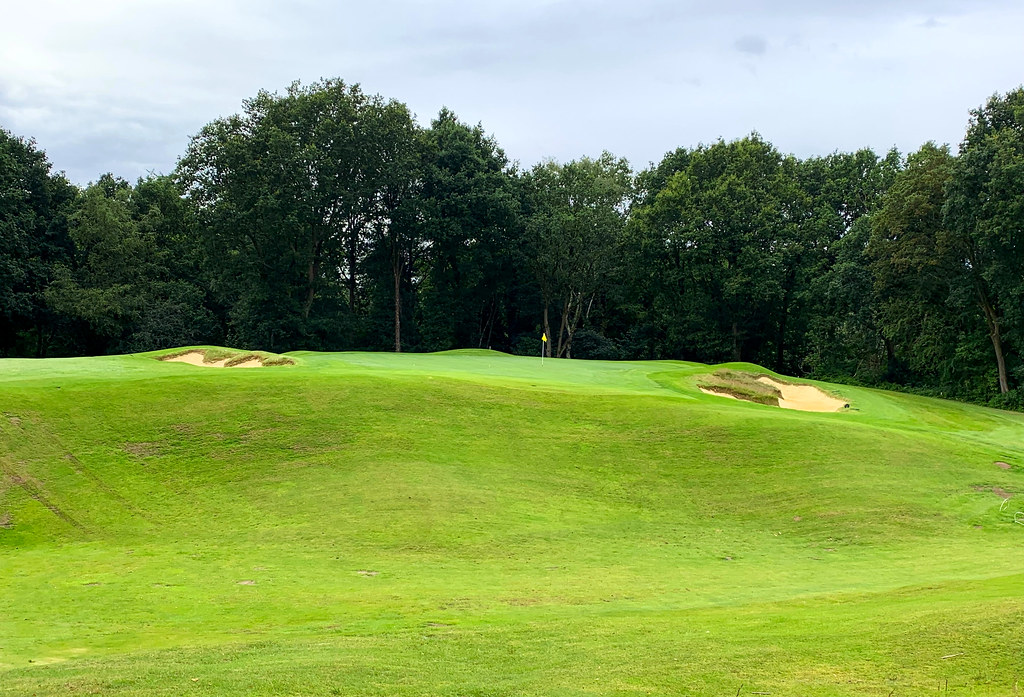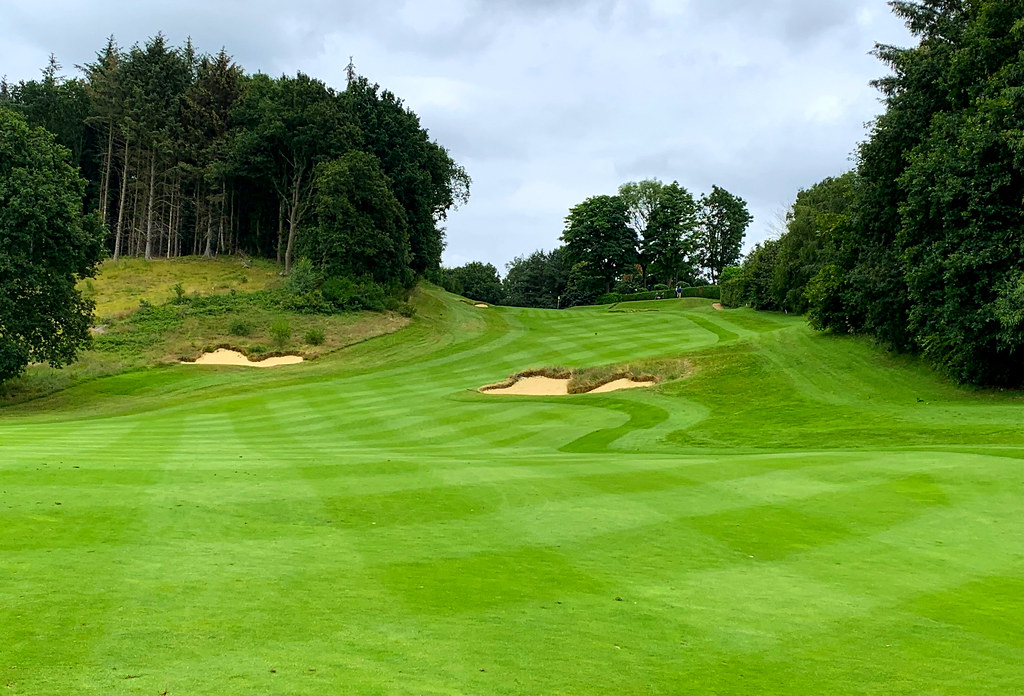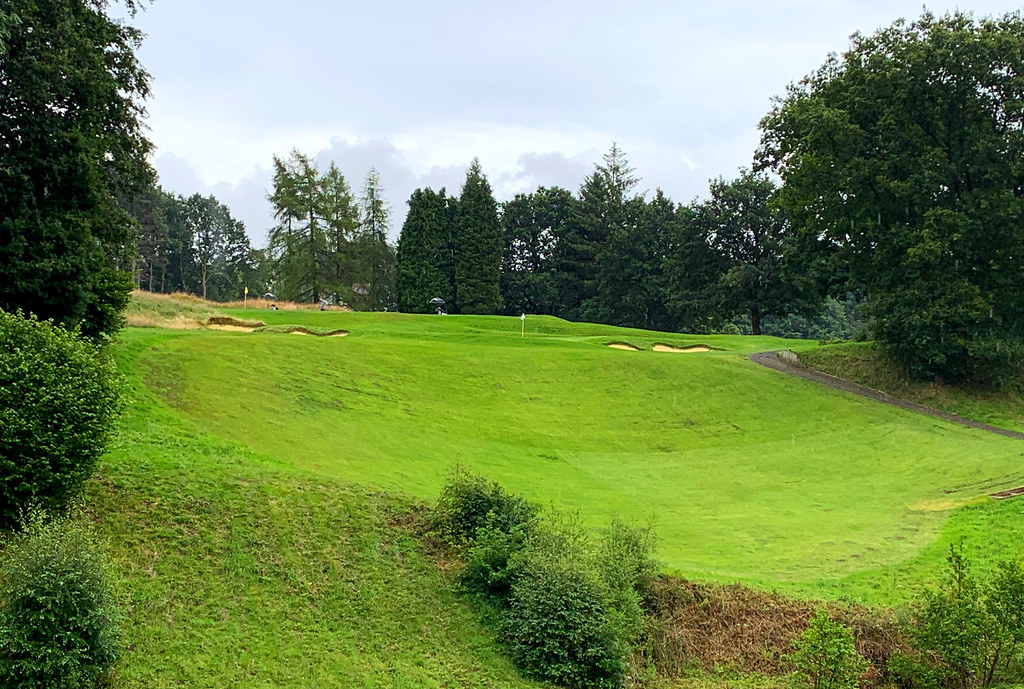I had the good fortune to make my way up to Cheshire and play Prestbury after a 15 year break. I must admit to knowing very little of the course other than Colt is the architect of record and that Morrison may have helped with the design at some stage. There is also scuttlebutt that Dr Mac was involved due to a newspaper article which claimed this to be the case. Although, I don't recall Dr Mac claiming credit in any of his literature.
The course sits on a very hilly property not far south of Manchester near Macclesfield, in a tony neighbourhood. In truth, the course is likely a bit too mountainous for ideal golf, but Colt dealt with the severity of the terrain admirably. The card tells us the total yardage from the daily tees is not much shy of 6200, but as is so often the case with Colt's work the course can play longer. I find Prestbury a fairly difficult test despite not having many onerous requirements. Finally, I am greatly impressed with the many boozer loops which can be played on this compressed design.
Plan of the course.

We get a sense of scorecard length not meaning much on the first hole, a short par 5 of 459 yards, but one which takes two very good swipes to reach the green. Two decent shots leaves a wedge in the hand, but judging the depth of the green is difficult.

#2 takes the golfer down hill between more equi-distant bunkers right and left. The green seems as though it is propped up from the rear. Missing the putting surface leads to serious trouble. Below is a look at the recovery from the high right side of the green.

The course says hello on the third. If one is long enough the drive is blind with a landing zone slipping sharply away from the crest of a hill. Below is the approach from the left side of the fairway to a magnificent green site tagged to a rapidly rising hill. Trees behind the green to the right, toward the 4th tee have been removed. There is some very dubious cut patterns which distract from the quality of the hole.

Playing sharply downhill, the 4th is a mid-length one-shotter.

An old photo of the green. Looks to me like the green is much smaller these days. It is also clear that Prestbury has immense work ahead if it is to recreate the interior views which once existed.

The fifth is a short par 4 that is reachable in theory, but I am sure the photo explains why it isn't in reality. I reckon its better to lay back off the tee leaving the length of the green available for the approach. That said, the layup isn't easy. The fairway shy of the left bunker drops left to leave a blind approach.

Beyond the bunker is the place to be. There used to be steps where the bunker is located.

The steepness of the bank is difficult to appreciate in photos.

Other than the orientation of the approach, the 5th is distinguished from the 3rd by a bunker above the green. I believe sand used to completely surround this green. From the 6th tee it is apparent why driving pin high isn't clever.

I don't quite know how Colt managed it, but the second three-shotter, #6, is another that should be reachable on the card, but it plays longer than its listed 496 yards. The second climbs the hill and crosses the entrance road. However, it is the turning left of the hole which makes it difficult to get up in two. I don't know the function of the immediate tree on the right. From the back tee it forces drives left.


The hilly nature of the course hides the fact that Prestbury is compact. The seventh is another good short hole. The 6th green is in the immediate foreground. Another tree to the left...why? The rough shy of the dip looks lovely, but it may conceal the dramatic impact of the hole.

Below are closer looks at the green and its hidden surprise.


I think this is an old version the hole, although the green looks to be tilted the wrong way.

The 8th is an odd short two-shotter which bends hard left and would be drivable for the flat bellies except for the trees guarding the left corner (and I suspect the 7th tee). This is a curious hole because one must challenge the unseen hazard through the fairway to gain the best angle of approach. The course feels awkward in this area. I wonder if a hole isn't original.
The side finishes with a hole of monster proportions. At 455 yards and climbing about 50 feet to the highest point of the course for the approach, the ninth is a hole which will require a deft short game for most to earn a par. The bunkering at the turn of the dogleg has been changed. More importantly, why are there so many trees blocking the view down the valley?

On the whole the bunkers are well placed and attractive. From here my well struck 4 wood came up miles short of the target. The greens at Prestbury are typical Colt if there is such a thing. Nothing flashy, but often beguiling. That said, Colt was not adverse to the odd adventurous green as the three tier green demonstrates; it majestically caps this harsh hole.

An old photo of the the uphill approach from a position further back.

I know little of the science of course routing, but Prestbury strikes me as one of outstanding merit. The back nine is routed around the front in a sort of horse shoe fashion. Interestingly, the back nine covers the highest part of the property at the 10th tee and lowest part at #12 green with an ease few architects could match. While the walk back up to the clubhouse involves some gentle climbing it never requires a long green to tee walk.
Totally transformed by new bunkering, the 10th is a deceiving knob to knob hole with a rather narrow green and well protected by sand left and right. Perhaps the green complex is a little too similar to the 8th, but it isn't a bad hole for that. Folks may be wondering why the course is so green. It is my impression that Manchester has not been spared the rain England has been deluged by this year. In any case, given the severity of the land, I am not sure keen conditions would be the most suitable.

The final par 5 could be Prestbury's best. Trees are a serious issue around the tee and for the drive. The tee shot requires a long and accurate strike to the left side of the fairway to reach the turn of the dogleg and avoid trrees. Anything too long on this line will run down to a wood. Anything terribly far right of this line makes going for the green in two an arduous task due to trees guarding the inside of the dogleg.
The 12th is visually odd from the tee. We must hit over a garden hedge and shape the shot left to right to earn a good angle of approach. Other than trees, obscured visuals from the tee or out and out blindness is perhaps Prestbury's biggest weakness. The site is lovely yet it often feels like one isn't afforded the views even thought there are usually consequences for not hitting the mark. For sure the construction date explains some of the tee shots. Thankfully, the hole improves immeasurably due to the approach. The golfer's first glimpse of a green is the 15th in the background. I thought this was the intended target until walking further up the fairway. I stated earlier that this green is the low part of the course and because of this the club recently carried out extensive drainage work.

While the slight uphill drive for number 13 is less than ideal, we are treated to one of the highlights of Prestbury for the approach.

The use of hills at Prestbury reminded me of my younger days playing a Ross gem, Grosse Ile, and the delightful 14th was like going home. The player may have the choice of driving over the knob to the valley floor for a flick wedge approach at the risk of catching a downhill lie to an uphill green. Alternatively, one can play for the top of the knob and be further back, but have a level lie to a green on more less the same elevation. My thoughts on this matter are undoubtably influenced by the situation of the tee shot because we stand at a marvelous confluence of holes. Like Ross often did, Colt demonstrates a remarkable economy of design. The 13th, 16th, 17th and 1st greens and 14, 17 and 18th tees all nearby. Tee shot for 14.

The lovely approach to #14. Notice how the left edge of the green flows up to the medal tee for #15. Unfortunately, that tee seems to be abandoned. Prestbury is packed with little details which help distinguish the course as true Colt gem.

Trees crowd the 15th to protect the road on the left. For the life of me I can't understand why trees are used so harshly on the right if the safety issue is on the left. The tree spoil what is a good short two-shotter. The green slides away down the hill beyond and the cross bunker effectively hides the landing zone for the approach unless one can hit a very long drive.

A closer look at the green.

We now turn back for home and play the only bunker free hole on the course. The 16th isn't a terribly long par 4, but positioning is crucial. Anything down the left leaves a severe side-hill lie. If one manages to hit the fairway a magnificent opportunity to use the terrain is evident. One can play short and right and let the slope turn the ball to the hole. The fairway is broken by rough...below is the difficult approach. Should the player misjudge the pace, a scar hollow to the right awaits. This is without a doubt one of the cleverest of Colt holes I have come across.

Knowing how skilled Colt was at creating endearing par 3s, perhaps my expectations are too high, but up to now the short holes have been good without being memorable. The entire putting surface can't be seen from the tee as it curls right around the bunker. In wet conditions, I think it is entirely possible to hit a spinning shot to the false front section of the green and watch it spin a considerable distance back down the bank.

Looking back to the tee and 16th green.

The home hole is slightly disappointing, but that is likely due to the collection of creativity experienced during the previous three or four hours. That said, this hole does take some playing as the two tier green is deceptively deep and well protected by sand.


Because the terrain at Prestbury is unruly and it therefore seems to me there may be some playability issues if the course were keen it is difficult to give it a 1*. That said, I would like to go back and see the course when it is drier because my fears may be unfounded. In any case, because there are so many compelling holes such as 3, 5, 7, 9, 14 & 16 I have a lot of time for Prestbury and anybody traveling through the area should strongly consider giving it a go. One final word, the more Colt courses I play the more I realize the importance of turf quality. I can find no discernible differences in the design quality of Prestbury compared to Colt's more famous heathland courses. What is, however, very noticeable, is the difference in turf quality between parkland and heathland golf. 2024
Ciao